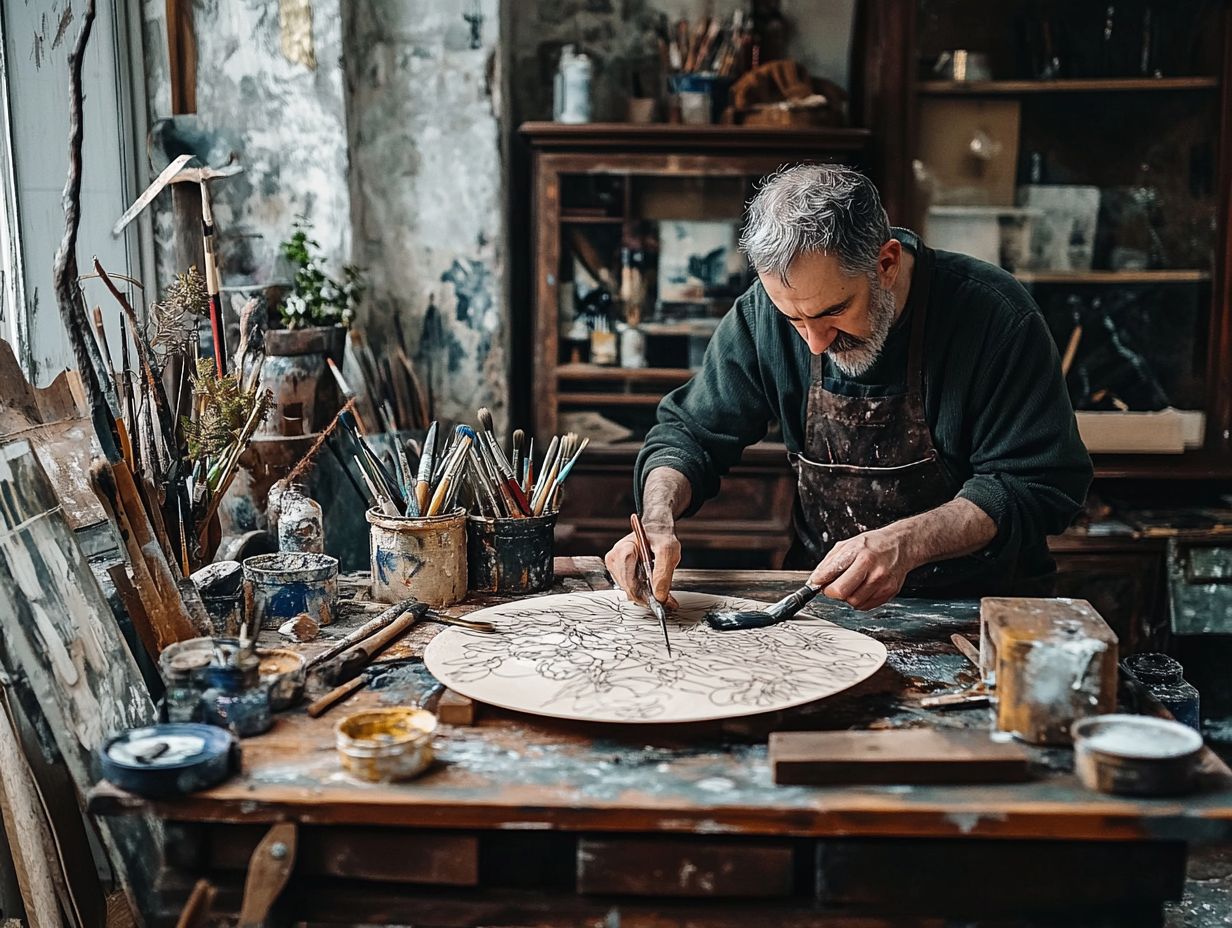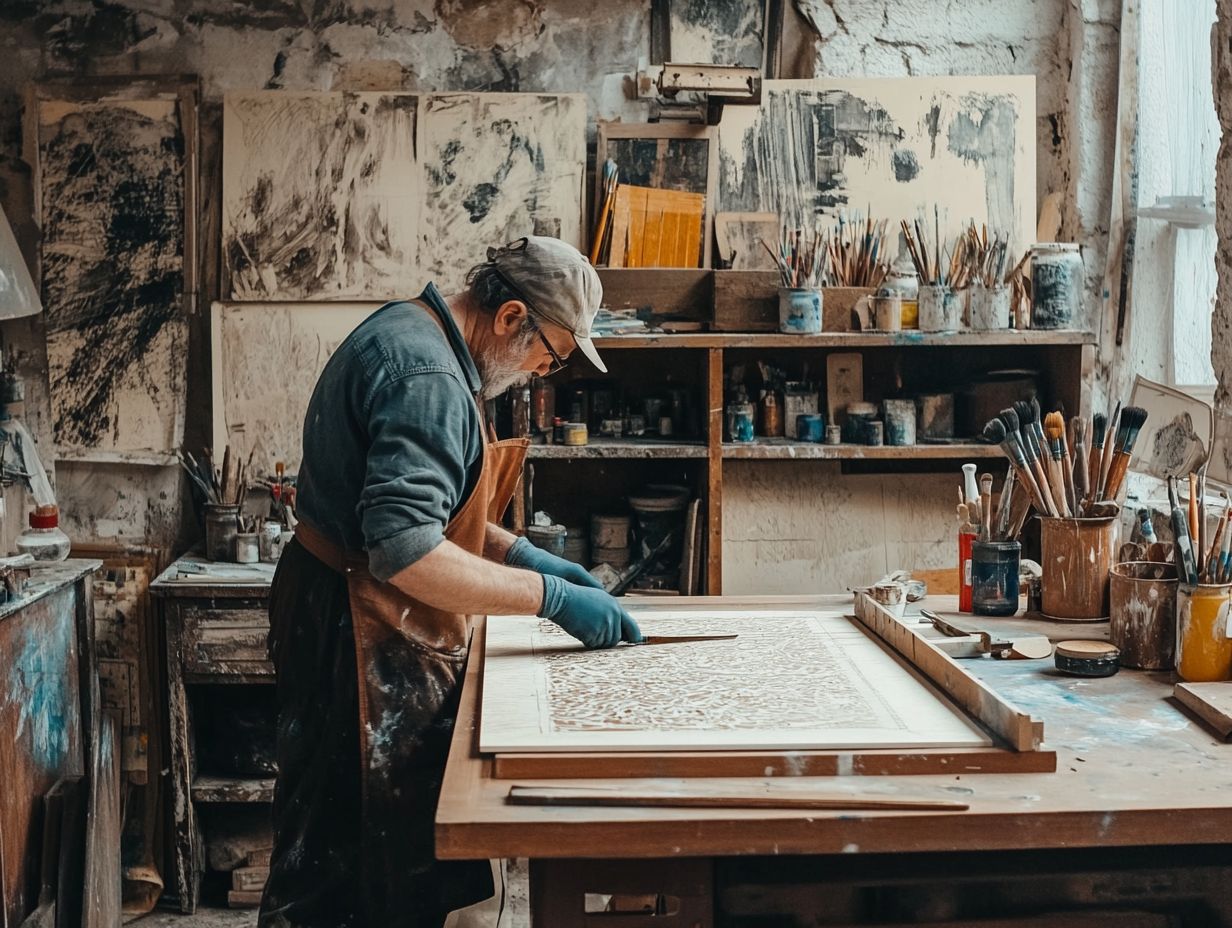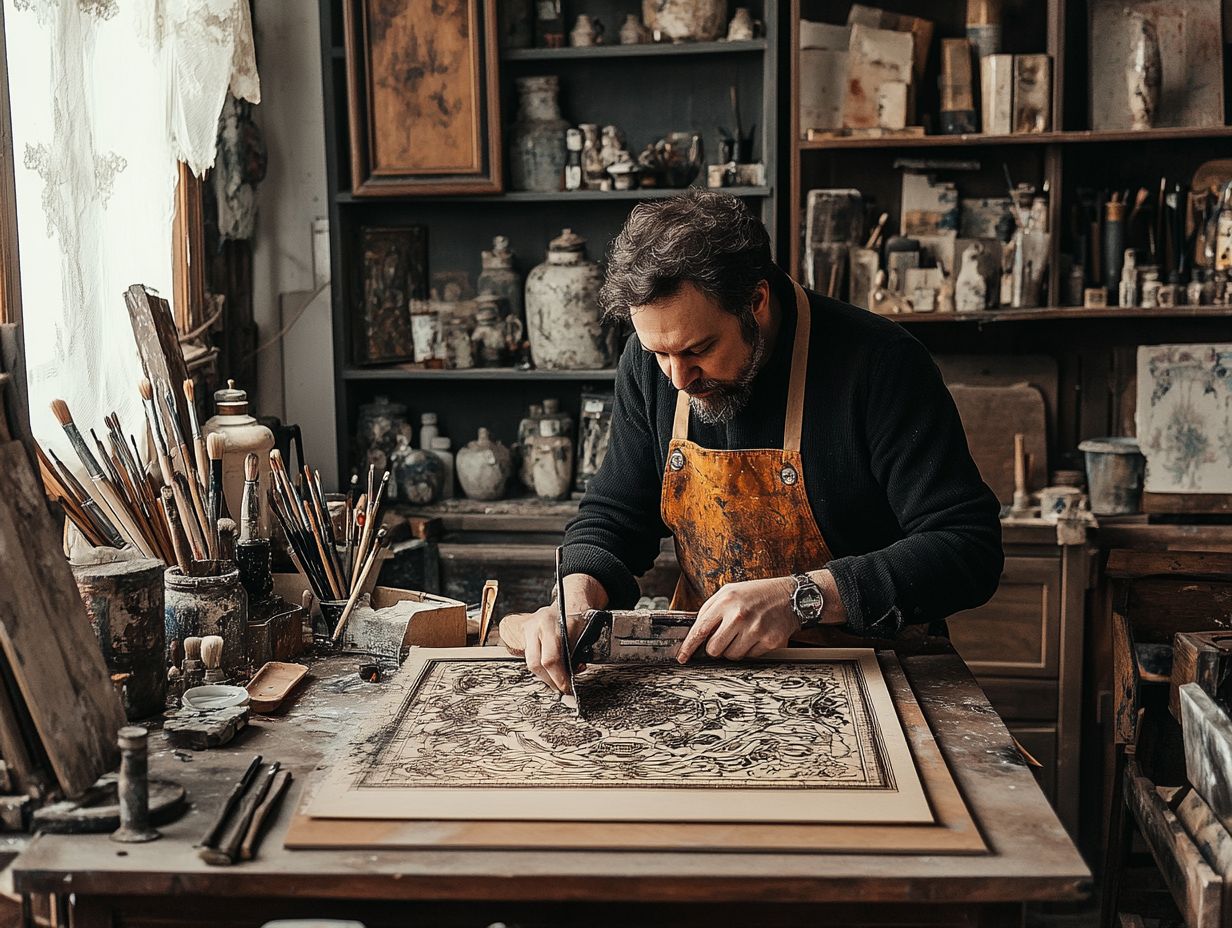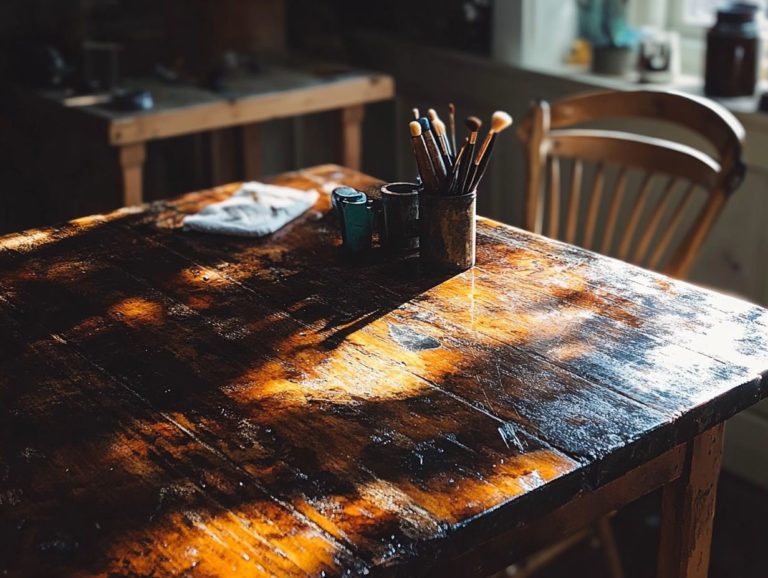Creating Custom Stencils for Vintage Furniture
Stenciling is your chance to transform vintage furniture into stunning pieces of art. With just a few artistic techniques, you can make any ordinary item extraordinary!
This guide delves into the benefits of utilizing custom stencils, highlighting everything from the enhancement of personalization to the provision of a cost-effective makeover solution for your DIY projects.
You ll learn about the essential materials you’ll need, explore detailed steps for creating your stencils, and discover tips for achieving flawless results in your crafting.
Prepare to be inspired by examples of beautifully stenciled vintage furniture and decorative pieces that are sure to ignite your imagination.
Get started and see how custom designs can elevate your furniture with this timeless craft!
Contents
- Key Takeaways:
- Benefits of Using Custom Stencils for Vintage Furniture
- Materials Needed for Creating Custom Stencils
- Steps to Create Custom Stencils
- Tips for Successful Stenciling
- Examples of Stenciled Vintage Furniture
- Frequently Asked Questions
- Why create custom stencils for vintage furniture?
- Do I need any special tools or materials to create custom stencils for vintage furniture?
- Can I use pre-made stencils for vintage furniture?
- How do I choose a design for my custom stencil?
- What is the best way to transfer the stencil design onto my furniture?
- How can I ensure my custom stenciling on vintage furniture lasts?
Key Takeaways:

- Custom stencils add a unique and personal touch to vintage furniture. They help your pieces stand out from mass-produced items.
- Using DIY methods to create custom stencils is cost-effective. It adds a designer touch to your furniture without breaking the bank.
- Proper technique, placement, and avoiding common mistakes are essential for successful stenciling results on vintage furniture.
What is Stenciling?
Stenciling is a creative method that allows you to create striking designs on a variety of surfaces using a stencil, which can be crafted from materials like Mylar a type of strong plastic often used for stencils or even simple paper. This practical DIY method enables you to reproduce intricate patterns effortlessly using supplies like Mylar, transforming ordinary furniture and home decor into stunning visual statements.
By using a cutting machine a device that cuts materials precisely like Cricut along with design space software, you can customize stencils to achieve both vintage and modern aesthetics, adding personality to any space with decorative touches that are both easy and budget-friendly.
With roots tracing back to ancient civilizations, stenciling has evolved over the centuries, serving as both a utilitarian tool and a form of artistic expression. Initially employed for marking ownership, it soon found its way into textiles, pottery, and architectural designs across cultures. Today, it s experiencing a vibrant resurgence, particularly in home improvement projects, where it enhances walls or accentuates furniture pieces with effortless style.
For example, you might choose stenciled motifs for your dining table, while businesses often utilize this technique for branding in commercial spaces using custom designs. The versatility of stenciling makes it a cherished choice for both DIY enthusiasts and professional decorators, allowing your creativity to flourish across various mediums.
Benefits of Using Custom Stencils for Vintage Furniture
Custom stencils for vintage furniture have numerous advantages that enhance both the aesthetic appeal and functional elements of your DIY endeavors, especially when working with unique patterns. These bespoke stencils offer an exceptional avenue to incorporate original designs that resonate with your personal style and the distinctive character of antique pieces, transforming them into captivating focal points within your home.
Whether you opt for an adhesive stencil or a reusable Mylar alternative, you can achieve intricate details typically reserved for professional-grade finishes using tools like the Cricut cutting machine. This ensures that your upcycled furniture is not only visually stunning but also remarkably cost-effective.
Unique Designs and Personalization
One of the most exhilarating aspects of stenciling is your ability to craft unique designs that seamlessly align with your personal style and the atmosphere of your home. You can achieve this especially by utilizing patterns available online.
By harnessing the versatility of custom stencils, you can effortlessly bring your vision to life. Whether you’re refreshing your walls, designing decorative pillows, or enhancing kitchen cabinets, think about themes that resonate with your interests. Perhaps botanical designs will appeal to the nature enthusiast, or sleek, contemporary lines will suit the minimalist aficionado.
Tools like Cricut offer user-friendly software and precision cutting, allowing you to create intricate designs with remarkable ease. Imagine crafting personalized signs for your garden or displaying your family name at an entryway; the possibilities are endless get ready to unleash your creativity!
With a dash of creativity and the right resources, custom stenciling transforms ordinary items into extraordinary treasures even on a budget!
Cost-Effective Solution
Stenciling provides a cost-effective pathway for anyone eager to refresh vintage furniture without draining their wallet on professional services. By investing in essential supplies like paint, adhesive stencils, and brushes, you can create stunning transformations that breathe new life into your old pieces.
This method encourages your creative expression while significantly reducing restoration costs. It’s a savvy choice for budget-conscious homeowners who enjoy DIY projects.
If you’re ready to dive into a stenciling project, you’ll be pleased to know that many materials can often be found at local craft stores or discount retailers. These options won’t stretch your budget, including affordable paint and supplies. Basic acrylic paint and DIY stencils can be grabbed for under $20. Using sponges or cut-up fabric for application, along with brushes, further trims expenses.
Tapping into online tutorials provides invaluable insights and techniques. This ensures your final result not only looks polished but also reflects your unique style. This hands-on approach allows you to achieve remarkable outcomes while keeping your finances firmly in check.
Materials Needed for Creating Custom Stencils

To craft custom stencils that elevate your DIY projects in home decor, gather a selection of materials and tools that ensure both precision and ease in your stenciling journey.
- Mylar sheets: Their durability and reusability make them a top choice for creating stencils that can be used multiple times.
- Cricut cutting machine: This tool brings your intricate designs to life.
- Exacto knife: Essential for achieving clean, crisp cuts.
- Cutting mat: Important for ensuring a smooth cutting experience.
- Adhesive spray: Vital for securing your stencil in place.
These materials will lay the groundwork for a seamless stenciling process. You ll achieve professional-quality results right in the comfort of your home.
So, gather your materials and let your creativity shine!
Essential Tools and Supplies
When you start a stenciling project, having the right tools and supplies is essential for achieving stellar results. You ll want to begin with a Cricut cutting machine for crafting precise stencils. Don’t forget adhesive sprays to keep those stencils secure, and opt for high-quality paint to elevate your final touches!
An X-Acto knife is worth its weight in gold for intricate cuts. A cutting mat provides a safe haven for all your crafting activities. These tools streamline your process and enhance the overall quality of your artistic creations, making each project a true reflection of your style.
To elevate your project even further, consider using painter’s tape to mask edges effectively, ensuring those clean lines you crave for your designs. A top-notch spray adhesive, like 3M Super 77, will keep your stencils in place without risking damage to your surface.
For paint, acrylics from Martha Stewart s line deliver vibrant colors and are easy to clean up. Foam brushes come in handy for applying paint smoothly and evenly, minimizing the risk of bleed under the stencil. These items are key to making your final creation truly shine.
Steps to Create Custom Stencils
Creating custom stencils is an art form that requires a careful method to achieve the stunning results you envision for your projects. From the initial design phase in Cricut Design Space a user-friendly design app for crafting projects to the precise cutting process, each step is vital to the final outcome.
Careful preparation is crucial. Selecting the right materials and fine-tuning the pressure settings on your cutting machine can make all the difference. This attention to detail ensures that your stencil adheres seamlessly, yielding clean designs that beautifully enhance your furniture and decor.
Designing and Cutting the Stencil
The process of designing and cutting a stencil is a delightful blend of creativity and precision. Start by utilizing Cricut Design Space to either select or craft patterns that resonate with your aesthetic, whether you gravitate towards geometric shapes or vintage motifs.
Once your design is ready in Design Space, the cutting machine will bring your digital creation to life, turning it into a usable stencil. Pay close attention to detail; the quality of your design and cut will affect your project’s outcome.
Before you dive into cutting, ensure the dimensions of your stencil are well-suited for the surface you plan to apply it to, whether it’s a wall or furniture. The grid feature in Cricut Design Space can be a game changer, allowing you to visualize the layout with ease.
When choosing a pattern, keep the intricacy level in mind; simpler designs and geometric shapes are more manageable, especially if you re just starting out. Once you ve perfected your design, adjust the blade settings the sharpness of the blade used for cutting according to the thickness of your chosen material.
Always conduct a test cut on a scrap piece to confirm your settings, helping you sidestep any mishaps when it s time to create your masterpiece. Get ready to make amazing stencils!
Preparing the Furniture for Stenciling
Get ready to transform your furniture into stunning pieces! Before diving into the stenciling process, it’s essential to prepare your furniture properly for the best results. This preparation involves cleaning the surface, sanding it down for improved paint adhesion, and applying a basecoat if necessary. A well-prepped surface not only enhances the longevity of your stenciled designs but also helps the paint adhere evenly, preventing peeling and ensuring a professional finish for your DIY project.
To achieve optimal results, start by thoroughly cleaning your furniture with mild soap and water, ensuring all dirt and grease are removed. Once the surface is clean, grab some sandpaper 220-grit works wonders and gently sand the area to create a smooth texture that helps the paint cling effectively.
Keep an eye out for any rough edges or imperfections, as these can impact your final design. When selecting a basecoat, choose a primer suited for your specific furniture material, whether it s wood, metal, or plastic. This step is vital for an even application later. Investing time in this preparation guarantees that your stencils will produce crisp, clear patterns, significantly enhancing any piece.
Tips for Successful Stenciling

For success in your stenciling projects, focus on the details and best practices to ensure your designs emerge crisp and vibrant. From choosing the right techniques for paint application to the meticulous placement of your stencil, every decision plays a pivotal role in the final outcome.
By following expert tips and avoiding common pitfalls, you can craft stunning decor pieces that showcase your unique style and elevate your furniture and home design.
Proper Technique and Placement
Mastering the right technique and placement is crucial for achieving stunning stenciled designs that elevate your decor to the next level.
To enhance the quality of your final product, selecting the right tools is essential. Investing in a soft-bristled stencil brush or a dedicated foam applicator can significantly improve your painting technique and overall results.
Securing the edges of your stencil with painter s tape is smart; it prevents any unwanted movement while you work, ensuring cleaner and more precise outcomes. Pay attention to the type of paint you choose as well; acrylic paint dries quickly and provides vibrant colors without sacrificing detail.
By practicing consistent pressure and using dabbing techniques starting with lighter colors and gradually transitioning to darker shades you can create depth and intrigue in your design, making your work truly stand out.
Common Mistakes to Avoid
When diving into the world of stenciling, be mindful of common mistakes that could compromise the quality of your work. Issues like paint bleed, improper stencil placement, and choosing the wrong type of paint can lead to less satisfying results.
By recognizing these pitfalls and taking proactive steps to avoid them, you can ensure that your stenciled designs are beautiful and durable, enhancing the overall appeal of your furniture and home.
First, paint bleed is a frequent issue that occurs when too much paint is applied at once. A smart solution is to use a dabbing technique with a stiff brush for precise paint application.
Another common error is improper stencil placement; securing the stencil firmly with painter s tape is crucial to prevent it from shifting. For instance, when stenciling a feature wall, aligning the design properly ensures a seamless look.
Opting for acrylic paint is often wise due to its quick drying time and excellent coverage, making it suitable for various surfaces. By considering these techniques and examples, you can significantly elevate your overall stenciling experience.
Start your stenciling project today and watch your furniture come to life!
Examples of Stenciled Vintage Furniture
Stenciled vintage furniture can transform any space. It showcases creativity and individuality with designs that stand out.
Picture intricately patterned dresses and elegantly stenciled chairs. These pieces do more than just enhance your decor they celebrate the timeless charm of antique furniture.
You have many techniques and styles to choose from. Stenciling has become a favored choice for DIY lovers who want to refresh their vintage treasures.
Inspiration and Ideas for Designs
Finding inspiration for your stenciling projects can spark creativity. It can lead to breathtaking transformations of vintage furniture.
Whether you re captivated by geometric patterns, floral motifs, or intricate vintage designs, the possibilities are truly endless.
Online resources, including design libraries and specialized DIY websites, offer a treasure trove of ideas. These can guide your artistic journey and allow you to add your personal touch to every piece.
Consider venturing into nature for inspiration. A leisurely stroll through a park could unveil captivating leaf shapes or unique color combinations that could translate beautifully into your stenciled designs.
Art history is another rich wellspring. Immersing yourself in works from various eras may introduce you to timeless aesthetics ripe for reimagining on your furniture.
Don t overlook the potential of everyday objects. Household items or textiles can reveal intriguing shapes and patterns waiting to be explored.
Engaging with communities on social media platforms can further spark your imagination. Sharing ideas and projects often leads to collaborative insights that are well worth your time.
Frequently Asked Questions

Why create custom stencils for vintage furniture?
Custom stencils let you personalize your furniture. This gives it a unique look that reflects your style.
Do I need any special tools or materials to create custom stencils for vintage furniture?
Yes, you will need stencil materials like mylar or cardstock, a cutting tool, and paint or ink for stenciling.
Can I use pre-made stencils for vintage furniture?
While pre-made stencils are available, creating your own allows for more creativity and customization. Plus, pre-made stencils may not fit your furniture’s dimensions perfectly.
How do I choose a design for my custom stencil?
You can base your design on the style and era of your vintage furniture, or create your own using digital software or by hand.
What is the best way to transfer the stencil design onto my furniture?
You can trace the design onto the furniture, use transfer paper, or project the design onto the furniture with a projector.
How can I ensure my custom stenciling on vintage furniture lasts?
To ensure longevity, use good quality materials for stencils and paint or ink. Properly seal the stenciled design with a protective finish, and avoid placing heavy objects on the stenciled area.
Ready to breathe new life into your vintage pieces? Start stenciling today!






